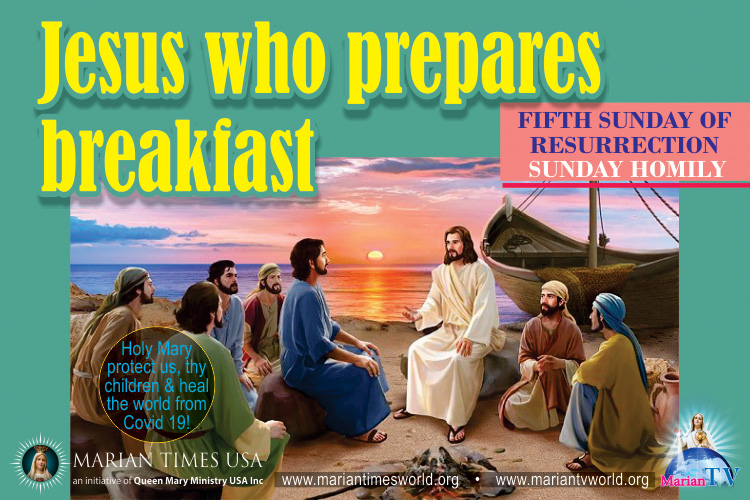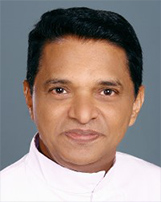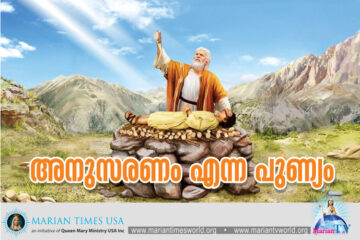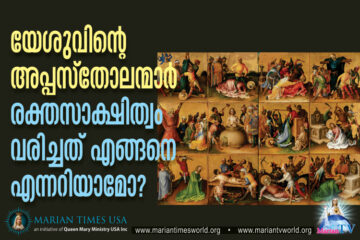JESUS WHO PREPARES BREAKFAST


~ Fr. Abraham Mutholath ~
Chicago, USA. ~
SUNDAY HOMILY: FIFTH SUNDAY OF RESURRECTION
INTRODUCTION
After his Resurrection, Jesus appeared to his disciples several times and empowered them with messages of hope. Seven of the disciples went for fishing so that they could get something to eat. When their attempt failed, Jesus appeared to them and guided them to get 153 large fish that filled their net. Jesus prepared breakfast for them with bread and fish, and distributed to them. Thus, the disciples again felt the support, hospitality and message of service from their Lord. Let us experience this support, love and message of Jesus when we participate in the Holy Mass and put that into practice in our daily lives.
Bible Text
The Appearance to the Seven Disciples.
(John21:1) After this, Jesus revealed himself again to his disciples at the Sea of Tiberias. He revealed himself in this way. (2) Together were Simon Peter, Thomas called Didymus, Nathanael from Cana in Galilee, Zebedee’s sons, and two others of his disciples. (3) Simon Peter said to them, “I am going fishing.” They said to him, “We also will come with you.” So they went out and got into the boat, but that night they caught nothing. (4) When it was already dawn, Jesus was standing on the shore; but the disciples did not realize that it was Jesus. (5) Jesus said to them, “Children, have you caught anything to eat?” They answered him, “No.” (6) So he said to them, “Cast the net over the right side of the boat and you will find something.” So they cast it, and were not able to pull it in because of the number of fish. (7) So the disciple whom Jesus loved said to Peter, “It is the Lord.” When Simon Peter heard that it was the Lord, he tucked in his garment, for he was lightly clad, and jumped into the sea. (8) The other disciples came in the boat, for they were not far from shore, only about a hundred yards, dragging the net with the fish. (9) When they climbed out on shore, they saw a charcoal fire with fish on it and bread. (10) Jesus said to them, “Bring some of the fish you just caught.” (11) So Simon Peter went over and dragged the net ashore full of one hundred fifty-three large fish. Even though there were so many, the net was not torn. (12) Jesus said to them, “Come, have breakfast.” And none of the disciples dared to ask him, “Who are you?” because they realized it was the Lord. (13) Jesus came over and took the bread and gave it to them, and in like manner the fish. (14) This was now the third time Jesus was revealed to his disciples after being raised from the dead.
Interpretation
Chapter 21 is an addendum to the gospel of John because John’s gospel had concluded at the end of chapter 20 stating: “Now Jesus did many other signs in the presence of [his] disciples that are not written in this book.But these are written that you may [come to] believe that Jesus is the Messiah, the Son of God, and that through this belief you may have life in his name.” (John 20:30-31). Chapter 21 illustrates the appearance of Jesus to seven of his disciples at the sea of Tiberias, Jesus giving Peter a chance to express his love of Jesus three times followed by Jesus assigning him to feed his sheep, comment of Jesus on John the Evangelist, and finally the conclusion similar to the previous chapter giving emphasis to numerous other things that are not recorded: “There are also many other things that Jesus did, but if these were to be described individually, I do not think the whole world would contain the books that would be written.” (John 21:25).
The evangelist has added an additional 25 verses of chapter 21 to give a positive impression on Peter who had denied Jesus three times after his arrest. John who loved Jesus and respected the leadership of Peter wanted to end his gospel expressing the loving relationship both of them had to Jesus. John also asserts the leadership of the church that Jesus assigned to Peter even after his resurrection.
(John21:1) After this, Jesus revealed himself again to his disciples at the Sea of Tiberias. He revealed himself in this way.
After this
It is John’s style to use “After this” at the beginning of a section or chapter to connect the event that follows to what had happened earlier. We see the same expression in his gospel in 5:1, 6:1, and 7:1. It need not be an immediate succession but can be after a short interval as in this case.
Jesus revealed himself
John the Evangelist presented the first miracle of Jesus at Cana as a revelation of his glory. “Jesus did this as the beginning of his signs in Cana in Galilee and so revealed his glory, and his disciples began to believe in him.” (John 2:11). The appearance of Jesus to his disciples after his resurrection was to reveal himself to increase the faith of his disciples in his resurrection.
Jesus revealed himself again
The evangelist used the term “again” to denote that Jesus had manifested to the disciples after his resurrection previously. Jesus had appeared “to them during forty days and speaking about the kingdom of God.” (Acts 1:3).The following are the recorded appearances of Jesus after his resurrection:
- To Mary Magdalene in Jerusalem on the Resurrection Sunday (John 20:11-18, Mark 16:9-11).
- To a group of women in Jerusalem on Resurrection Sunday as presented by the Synoptic gospels: “Mary Magdalene and the other Mary”(Matthew 28:1,9), “Mary Magdalene, Mary, the mother of James, and Salome” (Mark 16:1), “Mary Magdalene, Joanna, and Mary the mother of James; the others who accompanied them” (Luke 24:10).
- To Simon Peter in Jerusalem on the Resurrection Sunday (Luke 24:34, 1 Cor 15:5).
- Cleopas and his companion on the road from Jerusalem to Emmaus on the Resurrection Sunday (Luke 24:13-35).
- To ten apostles excluding Thomas in Jerusalem on the Resurrection Sunday (John 20:19-25).
- To the 11 apostles including Thomas in Jerusalem on the 8th day after the Resurrection (John 20:26-29).
- To seven disciples,“Simon Peter, Thomas called Didymus, Nathanael from Cana in Galilee, Zebedee’s sons, and two others of his disciples” (John 21:2), who were fishing at the Sea of Tiberias in Galilee within a few weeks after the resurrection and before the ascension on the 40th day.
- To the 11 disciples at a mountain in Galilee within a few weeks after the resurrection (Matthew 28:16-20).
- To “more than five hundred brothers at once” (1 Cor. 15:6) and to James (1Cor. 15:7). Location is unknown and happened within a few weeks after the resurrection.
- To the apostles in Jerusalem and led them to the Mount of Olives just before his ascension on the 40th day (Luke 24:50-52, Acts 1:4-9).
Thus the appearance of Jesus to the seven disciples at the Sea of Tiberias was the third manifestation of the Risen Lord to these apostles, and his seventh appearance to the disciples at large.
at the Sea of Tiberias
Sea of Tiberias is another name of the Sea of Galilee. John used both names in his gospel (6:1). Though it is traditionally known as sea, it is in fact a freshwater lake. The other names of this lake are Lake of Gennesaret and Lake Kinneret. This lake is around 13 miles (21 kilometers) north-south, 8.1 miles (13 km.) wide, 33 miles (53 kilometers) circumference, and 141 feet (43 meters) deep. It is mainly fed by the Jordan River from the north and by underground springs. The Jordan river continues from the south of the lake to Dead Sea. The Sea of Galilee is the lowest freshwater lake on earth and the second lowest lake in the world after the Dead Sea which is a saltwater lake.
The name Sea of Tiberias came from the name of the City of Tiberias on the western shore of the Sea of Galilee. King Herod Antipas builtit around 20 AD. He made it as his capital for Galilee and named in honor of the Roman emperor Tiberius. It was at the proximity of 17 natural mineral hot springs. Conservative Jews were reluctant to settle here because of the presence of a cemetery that would make them and priests ritually unclean. So Antipas settled gentiles here. Later, many Jews also inhabited here. Because of the prestigious city of Tiberias, the Sea of Galilee was also known as the Sea of Tiberias. Only John used this name to make the gentiles better understand the location.
(2) Together were Simon Peter, Thomas called Didymus, Nathanael from Cana in Galilee, Zebedee’s sons, and two others of his disciples.
Together
Though the Evangelist presents only seven of the disciples out of 11, the number seven is biblically a perfect number like three, ten, or some other numbers. The absence of the four was not significant because the seven were a representative body of all the apostles. This is similar to three of the apostles – Peter, James and John – who were with Jesus on rare occasions as a representative body of all the apostles. Besides,apostles like Matthew werenot fishermen.
Simon Peter
Simon, whom Jesus surnamed as Peter, was a fisherman and brother of Apostle Andrew. Simon Peter had natural leadership qualities and was not afraid in expressing his opinions. Jesus used his house in Capernaum as a base for his ministry for some time. Simon professed his faith in Jesus at Caesarea Philippi saying “You are the Messiah, the Son of the living God.” (Matthew 16:16), Jesus changed his name Simon meaning “God has heard,” to Peter (Rock). Among the apostles, only Peter had that privilege of Jesus changing the name.Jesus gave authority to Peter saying, “I will give you the keys to the kingdom of heaven. Whatever you bind on earth shall be bound in heaven; and whatever you loose on earth shall be loosed in heaven.” (Matthew 16:19).In spite of the warnings he had received from Jesus, he denied Jesus three times during the trial of Jesus. However, he had recovered from it through his genuine repentance.
Thomas called Didymus
The original name of St. Thomas, according to tradition, is Judas Thomas or Judas the Twin. Thomas is a Hebrew name and Didymus a Greek name. The literal meaning of Thomas is twin originated from Te’oma in Aramaic and Didymos in Greek (John 11:16). Probably St. Thomas had a twin brother or sister. Both the names signify twin because Thomas was one of the twins in his family. Jews used to have a Jewish name and a gentile name. In Judea, they were known by their Hebrew name and in Galilee and other non-Jewish areas they were called by their gentile name.
Thomas is believed to be of the same age of Jesus. He expressed his boldness to die for Jesus when the other disciples discouraged Jesus from going back to Judea to see the sick Lazarus saying: “Rabbi, the Jews were just trying to stone you, and you want to go back there?” (John 11:8). Thomas encouraged them saying: “Let us also go to die with him.” (John 11:16). However, Thomas was not at the foot of the cross when Jesus was crucified. He doubted the resurrection of Jesus when other disciples said that they had seen the Risen Lord. So Thomas is nicknamed as “Doubting Thomas.” However, he expressed his great faith in the Lord by declaring to Jesus, “My Lord and My God.” (John 20:28). Thomas preached in Parthia, Persia and India. While he was abroad, the Blessed Mother Mary died and he reached at her home on the third day after her death. Upon his insistence, the tomb of Mary was opened and her body was not found. Thomas saw Mary being taken up to heaven. Thomas was stabbed to death by a spear at Mylapore in India in 72 AD. This has some similarity to the death of Jesus because the heart of Jesus was pierced by a spear.
Nathanael from Cana in Galilee
Only John uses the name Nathanael in the gospel. He can be Bartholomew as given in the Synoptic gospels. He was from Cana in Galilee and that is mentioned here to recollect the first miracle of Jesus at a wedding feast at Cana (John 2:1-12). It was after the first miracle at Cana that the disciples began to have good faith in Jesus.
Philip introduced Jesus to Nathanael. When Jesus saw Nathanael, he said of him: “Here is a true Israelite. There is no duplicity in him.” (John 1:47). Response of Nathanael to Jesus was a profession of faith: “Rabbi, you are the Son of God; you are the King of Israel.” (John 1:49). Jesus promised Nathanael: “Amen, amen, I say to you, you will see the sky opened and the angels of God ascending and descending on the Son of Man.” (John 1:51). Nathanael preached in India and then at Asia Minor. He was martyred by skinning alive in Armenia in 72 AD.
Zebedee’s sons
Though not named here, the Zebedee’s sons were James and John.Like Peter and Andrew, James and John were brothers and fishermen. Zebedee, their father was a leading businessman of fishing. Zebedee had hired men to run the business. (Mark 1:20). Jesus had nicknamed James and John as Boanerges, that is, sons of thunder. This was because of their intense passion and enthusiasm. They, along with the help of their mother Salome, had asked opportunity to sit on both sides of Jesus in his kingdom (Matthew 20:20-23). They were also the inner circle of Jesus along with Peter. These three were the only people allowed to accompany Jesus to witness raising Jairus’ daughter to life (Mark 5:37), to the Mount of Transfiguration (Mark 9:2), and to be close with Jesus in the Garden of Gethsemane (Mark 14:33). These three were here also, along with other four, to experiencethe Risen Lord.
two others of his disciples
John at times skip giving the names of persons. For example when John the Baptist introduced his disciples to Jesus, John recorded “The next day John was there again with two of his disciples.”(John 1:35). One of them was Andrew and name of the other was not mentioned. Scholars believe that it must be John himself because he tried to avoid his name in his writings. Here the two disciples who were there are anonymous. Some scholars believe that the two unnamed could be two disciples of Jesus in a wider sense and not apostles. Some others believe that they were Andrew and Philip based on John 1:35.
(3) Simon Peter said to them, “I am going fishing.” They said to him, “We also will come with you.” So they went out and got into the boat, but that night they caught nothing.
Simon Peter said to them …
This shows the leadership quality, decision making capacity and initiative of Peter. The other six agreed with him and followed him for fishing because they all felt that it was a right decision. It was probable that the family of Peter and Andrew, and Zebedee’s sons had preserved the boat and net they had once given up to follow Jesus. Or they might have hired them from their previous fishermen friends.
“I am going fishing.”
The apostles had once left their profession to follow Jesus. Is it justifiable for them to return to something that they had abandoned for the sake of the Kingdom of God? There are different views among scholars. There are some factors that justify the acts of the seven disciples.
- During the public ministry of Jesus, pious women followers of Jesus had supported the team of apostles and Jesus (Luke 8:1-3). After the crucifixion of Jesus, the apostles must have beenstarving. Instead of seeking others help, they might have thought of using their skills to support themselves at least for a while.
- While the apostles were with Jesus during his public ministry, they were fully occupied. After the death of Jesus, they had nothing else to doother than prayer. So they might thought of some physical activity that could be beneficial for them and others.
- In the divine providence, their unsuccessful attempt to catch fish could add to their understanding of the Lord who wanted them to be fishers of men. They learnt a lesson that Jesus, who had no fishing experience, could guide them when they fish people for the church.
that night they caught nothing
Fishing was done usually at night for several reasons:
- Fresh fish had to be presented for sale at the lakeshore early in the morning. Since the fishermen had no ice to preserve the freshness of the fish, the fishing had to take place late at night.
- Fishing during day light was not effective because fish could see the boat, fishermen and net. At night the fishermen used torch to attract the fish to them while hiding the rest from their view.
- If their target was nocturnal fish, they were available or active only at night.
- The wind is favorable to sail after midnight because it blows from the land to the sea at that time. When the sun is up in the early morning, the sky will be attractive with a golden hue light on the sky. The fish comes up to the surface at that time. This becomes favorable for the fishermen to catch the fish with their nets or other fishing tools.
The disciples who were experienced fishermen did their best. However, they failed to get any catch. It could be a natural event but also can be interpreted as a divine plan for the actions and message to follow. Failures in life should not discourage us or make us feel that God has abandoned us. They can lead us to better result according to God’s design. The failures in human understanding can be God’s means for success or a glorious stage as it happened in the case of Jesus.
(4) When it was already dawn, Jesus was standing on the shore; but the disciples did not realize that it was Jesus.
When it was already dawn
Because of the fruitless effort, the seven disciples were returning to the shore by dawn. They were not expecting the Risen Lord there.
but the disciples did not realize that it was Jesus.
Even when the seven disciples came close to the beach, they did not recognize Jesus first. People might come at dawn to buy fish from the fishermen. So they did not notice anything special in the presence of this stranger who turned out to be Jesus. There were several instances when those who saw Jesus after resurrection had a hard time recognizing him:
- When Jesus appeared to MaryMagdaleneshe thought he was a gardener (John 20:15) and recognized him only after he called her by name (John 20:14-17).
- When Jesus appeared to the Apostles on the first day of resurrection, “they were startled and terrified and thought that they were seeing a ghost.” (Luke 24:37).
- Though Jesus joined Cleopas and his companion on their journey from Jerusalem to Emmaus on the Resurrection Sunday, their eyes were prevented from recognizing him (Luke 24:16). Later, “while he was with them at table, he took bread, said the blessing, broke it, and gave it to them. With that their eyes were opened and they recognized him.” (Luke 24:30-31).
- When seven disciples, “Simon Peter, Thomas called Didymus, Nathanael from Cana in Galilee, Zebedee’s sons, and two others of his disciples” (John 21:2), were fishing at the Sea of Tiberias in Galilee saw Jesus on the shore, they did not recognize until they had a miraculous catch of fish at the direction of Jesus(John 21:1-14).
The reason for difficulty in recognizing the Risen Jesus was because of his transformed spiritual body. Though Jesus raised Lazarus (John 11:1-44), the son of the widow in Nain (Luke 7:11-17), and Jairus’ daughter (Luke 8:49-56), they came back to life with their natural body. However the risen body of Jesus was different and perfect without limitations of the physical laws. That was why he could appear and disappear like angels and could enter through locked doors (John 20:19).
The resurrected body of Christ is an indication for the redeemed on how their imperfect earthly body would be transformed in the heavenly realm. According to St. Paul’s first letter to Corinthians chapter 15:40-49, the heavenly bodies are bright, incorruptible, glorious, powerful, spiritual, heavenly, and bear the image of the heavenly one. Though the risen bodies could be recognizable,they would be different and perfect.
The body of the Risen Jesus was different in appearance and characteristics. However, he was also close to how he looked like during his public ministry. That was why the disciples, though misunderstood first, could recognize him and were convinced that he had risen from the dead.
(5) Jesus said to them, “Children, have you caught anything to eat?” They answered him, “No.”
The word “children” did not mean any affection or expression of close relationship. It was a normal salutation to strangers also. Jesus did not want to reveal his identity at that time. The fishing industry was not just for the food of the fishermen but also for sales of fish. However, noticing the unsuccessful attempts, Jesus was asking them whether they caught at least for their food. Their negative reply was an expression of their helplessness.
(6) So he said to them, “Cast the net over the right side of the boat and you will find something.” So they cast it, and were not able to pull it in because of the number of fish.
The attempts of the disciples to catch the fish at that time might have been to the left side of their boat. Jesus instructed them to cast the net over the right side. Right side has positive meaning and is presented throughout the Bible. Jesus, though felt like a stranger to the disciples at that time, did not assure them a great catch. They might have thought that they might get something to eat at that time.The disciples obeyed the “stranger” because they thought that he could see a shoal of fish from the shore. So they trusted him and did their final attempt. When they obeyed the stranger’s direction, they got an unbelievable catch of fish. They could not even pull them ashore because of the huge number of fish.
(7) So the disciple whom Jesus loved said to Peter, “It is the Lord.” When Simon Peter heard that it was the Lord, he tucked in his garment, for he was lightly clad, and jumped into the sea.
the disciple whom Jesus loved
This usage is seen only in the gospel of John. From the early church onwards, it is believed to be a reference to John himself. There are five occasions when John uses this phrase in his gospel:
- John 13:23. At the last supper when John was reclining with Jesus along with other apostles.
- John 19:26. When Jesus entrusted his mother to John while on the cross.
- John 20:2. When Mary Magdalene reported the empty tomb to Peter and John.
- John 21:7. When John identified to Peter that Jesus was on the shore directing them for the miraculous catch of fish.
- John 21:20. Peter asking of John’s end of life to Jesus after Jesus told about how Peter would die.
The author out of his modesty was not using his name or “I” at these places. Another reasoning is that because of the persecution when the gospel was published, the author was concealing his identity for security reasons while his readers would recognize who he was.
he tucked in his garment
Peter had minimum dress as usual for a fisherman during the fishing. When he came to know from John that it was the Lord, he out of respect for his master put on his garment to meet and greet Jesus.
jumped into the sea.
When Peter realized that it was Jesus who instructed them to cast the net at the right side of the boat for the miraculous catch of fish, he ignored the boat, fish, and his coworkers. Out of enthusiasm to greet the Lord, he jumped into the sea to swim hundred yards rather than being patient to wait the boat to reach the coast with a heavy load of fish. Such was his love for the Lord and initiative to meet him.
(8) The other disciples came in the boat, for they were not far from shore, only about a hundred yards, dragging the net with the fish.
The other six disciples did not leave the boat or the net with abundant fish. They had to drag the net with the fish to the shore on the boat.
(9) When they climbed out on shore, they saw a charcoal fire with fish on it and bread.
No one knows how or from where Jesus got the fish and bread for cooking. There was no mention of anybody else present there at that time. However, the important lesson here is the care of Jesus for his hungry and tired disciples who were also disappointed after the whole night labor in vain. Even the first question Jesus had to his disciples when he saw them was “Children, have you caught anything to eat?” (John 21:5). Jesus himself got fish and bread either by a miracle or from others. He showed hospitality to his seven disciples like a family member. Fish and bread could mean enough quantity of fish and bread for all the disciples to eat.
(10) Jesus said to them, “Bring some of the fish you just caught.”
Though Jesus prepared the food for them, he allowed them to add the fruit of their labor also as a part of their meal. There is satisfaction in consuming the result of one’s own labor than enjoying food provided by others.
(11) So Simon Peter went over and dragged the net ashore full of one hundred fifty-three large fish. Even though there were so many, the net was not torn.
So Simon Peter went over and dragged the net ashore
Though Jesus asked all the disciples in commonto bring some of the fish that they had caught, it was Simon Peter who went to get the fish for cooking. That also shows Peter’s initiative for rapid action because of his natural leadership quality. He was also excited at the presence of the Risen Lord. The other disciples might have helped him. John, who was eyewitness to this gives importance to the leadership role of Peter.
Net full of … large fish
Net was full is indicative that they got maximum number of fish that the net could contain. The fish were large, also specifies that the catch was at an optimum level. Usually the catch of fish would also contain small and worthless fish that would be thrown into the lake as Jesus mentioned in Matthew 13:37-48.
The abundance of large fish that filled the net without tearing it, is interpreted as the church that Jesus established would contain high quality Christians caught by the “fishers of men.” Though there were a lot of fish (people) in the sea (world), only high quality fish (faithful) were caught in the net that stands for the church under the external guidance of Jesus.
Net full of one hundred fifty-three large fish
Why John mentioned the number of fish here? Bible scholars attribute different meanings or reasons for this. The simple and natural reasoning is that after the labor, the fish were counted to divide among the partners and laborers. So the number was easily available.
Several attempts are made to give special meaning to number 153.
- According to St. Cyril of Alexandria, 153 which is a sum of 100, 50 and 3 have specific meanings. 100, a number of fullness represents gentiles. The full flock of sheep of a shepherd was 100 as given in Jesus’ parable (Matthew 18:12) and the full yield of good seed according to Bible was hundredfold (Genesis 26:12, (Matthew 13:8). Fifty stands for the remnant of Israel that God would gather (Jeremiah 23:3). And three stands for Holy Trinity.
- St. Augustine gives another interpretation. There are ten commandments and seven gifts of the Holy Spirit. The sum of both is 17. The sum of 1 through 17 (1+2+3+ …) is 153. So 153 fish stand for all who are saved through keeping the commandments of God and blessed by the gifts of the Holy Spirit.
- According to St. Jerome, there were 153 species of fish in the lake. So the number is indicative of all kinds of people in the world who would be accommodated in the church by the disciples of Jesus.
Even though there were so many, the net was not torn.
The regular catch of fish would not fill the net and so the fishnetswere not made so strong. When there was a miraculous catch of fish by Simon Peter and others at the direction of Jesus, “they caught a great number of fish and their nets were tearing(Luke 5:6). That is why the evangelist reports that in this case the net was not torn.Jesus protected the net from tearing to show that his church will never be destroyed and can contain large quantity of faithful.
(12) Jesus said to them, “Come, have breakfast.” And none of the disciples dared to ask him, “Who are you?” because they realized it was the Lord.
Jesus once again became a servant to his disciples. Through his hospitality and service to the physically weak disciples, Jesus taught the quality of humility and service needed for a Christian.
There was no reason for the disciples to ask Jesus who he was because they all saw him and were convinced of his identity. They had a reverential silence at the presence of Jesus. This was another proof for the resurrection of Jesus.
(13) Jesus came over and took the bread and gave it to them, and in like manner the fish.
Jesus was serving the bread and fish using almost the same manner and words after the multiplication of bread and fish in John 6:11. Bread and fish was the normal menu of people there those days. This also reminds us of the Last Supper where Jesus gave them bread (Matthew 26:26) and wine as his body and blood. However, this was not a Eucharistic meal. No prayer or blessing is mentioned here except the divine presence of Jesus.
(14) This was now the third time Jesus was revealed to his disciples after being raised from the dead.
Though Jesus appeared six times to various disciples before, this was the third revelation of Jesus to his apostles. The first was to the ten apostles excluding Thomas in Jerusalem on the Resurrection Sunday (John 20:19-25) and the second was to the 11 apostles including Thomas in Jerusalem on the 8th day after the Resurrection (John 20:26-29). John the Evangelist was participant of all these three revelations.
Message
- During his public ministry all kinds of people – Jews and gentiles, righteous and sinners, leaders and ordinary people, healthy and sick – saw Jesus. He had invited all of them to join his kingdom. However, after his resurrection, he appeared only to his disciples. Only those who believe and follow his teaching will be able to Jesus face to face in heaven. Let us try for this privilege.
- Jesus revealed to the disciples after his resurrection when they felt that they were at a loss. He kept up his promise that they will see him after a while. He keeps appearing to us and sharing his spiritual meal with us during the Holy Mass in the church. Let us welcome him with reverence.
- When the experienced fishermen failed to catch fish, Jesus directed them from outside their boat. Though Jesus sits at the right hand of his Father, he directs us through his church for our spiritual development. Like the disciples who followed his directions and got the great result, let us also follow the directions of Jesus and his representatives.
- Jesus prepared and served food to his disciples who were weak and hungry like a family member. That was a great experience for the disciples. Jesus offers us a similar experience during the Holy Sacrifice he offers in our churches.
- John, the one Jesus loved most, was able to recognize him first at the dim light of the dawn. When we are close to Jesus, we will be able to recognize the Lord more than others.
- Failures, like the disciples experienced, are natural in life even when we try our best in the right way. However, shortcomings and persecutions should not discourage us. God will intervene in time to lead the disasters into glorious outcomes.
- The church (net) will remain forever (not be torn) and will be filled with firm faithful (large fish) through the hard labor of the disciples of Jesus under the remote direction of Jesus. At the second coming of Christ, Jesus will fully separate his faithful saved through his church from the evils of this world and present them to his Father for the eternal banquet in heaven. Let us pray and try to attain this everlasting joy.
മരിയന് ടൈംസിലെ ഇന്നത്തെ പ്രധാനപ്പെട്ട അപ്ഡേറ്റുകള് താഴെ ലഭിക്കുന്നതാണ്.









